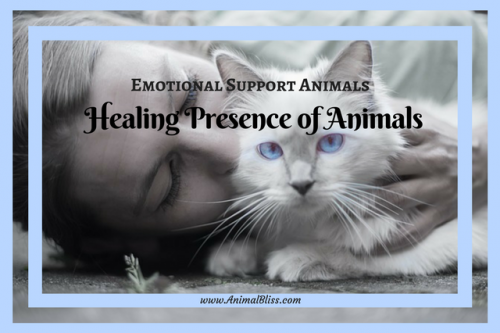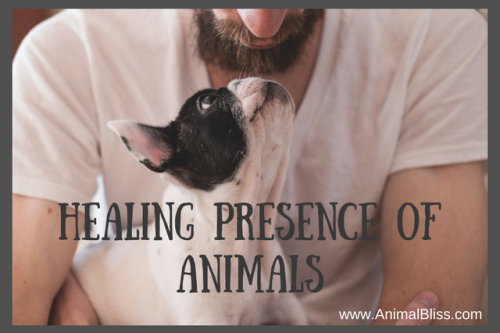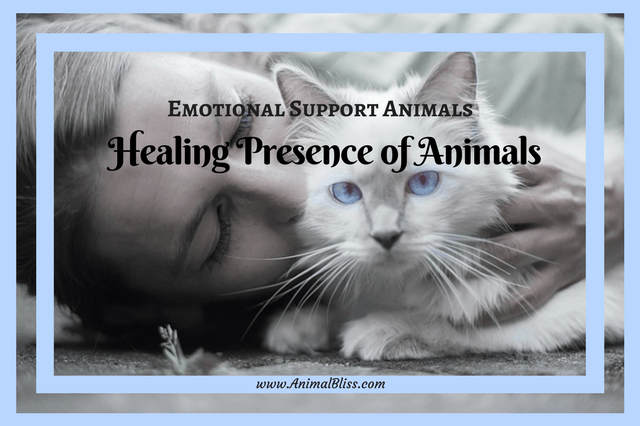Healing Presence of Animals
You come back home after a long stressful day at work, ready to shut yourself away from the world. Greeting you at the door is your dog, with a sympathetic look and a wagging tail. He seems to sense that something is the matter and curls up next to you. You bury your hands in his fur and start petting him. Things begin to calm down, and the world doesn’t seem so bad anymore. So many of us have experienced the healing presence of animals. The calming effect of animals on people recovering from trauma, surgery, and other issues is well-known and well-documented.

DISCLOSURE: Animal Bliss is a participant in the Amazon Services LLC Associates Program, an affiliate advertising program designed to provide a means for sites to earn fees by linking to Amazon.com and affiliated sites.
(In other words, we’ll get a very small (teeny tiny) commission from purchases made through links on this website. Thank you!)
An animal that provides this therapy is often a part of treatment for emotional or psychological issues and is known as an Emotional Support Animal (ESA). An ESA is prescribed by a licensed professional to be a person’s companion as they deal with emotional or psychological ill-health. This pet has to be a domesticated one, and the term ‘ESA’ encompasses many animals: dogs, cats, birds, snakes, rats, mice, rabbits, even hedgehogs, and ferrets. You could also get a little kitten or puppy as an ESA too. The healing presence of animals is far-reaching.
RELATED:
Ways Pets Can Help Those with Mental Illness
This animal companion concept might sound a lot like having a service dog, but there’s a difference. The latter is trained to deal with the owner’s health problems, for instance in the case of a seizure. In contrast, the ESA does not go through any training and works to provide a calming influence on the person needing it. Although there is no training involved, there is a requirement that the animal behaves itself or can be managed in public and in private.
While every animal provides emotional support, the ESA can only be called that if it belongs to someone certifiably disabled. Any medical doctor will not do this. The doctor will have to be a licensed practitioner of mental health — a psychologist, a therapist or a psychiatrist. The therapist will need to write a letter specifying the nature of the mental disability and the requirement for the emotional support animal. The letter must contain the practitioner’s license details, bear the official letterhead, and be dated as well. Once this process is approved, you will be allowed to live and travel with your animal.

The Healing Presence of Animals
Can cats qualify as ESAs? This is a valid question. We always speak of the difference between cat and dog — the latter being a people-pleaser, eager and willing to do what it’s asked to do. But the cat is a fickle creature. It doesn’t seem to care about anything but its creature comforts and is sometimes seen as being loyal to no one.
The truth is, though, that a cat makes for a great emotional support animal. It doesn’t matter what breed it is, from the majestic Persian to the slightly spooky Sphynx; a cat is an excellent animal to have around. In fact, a service cat can help a person with almost any kind of disorder. A new mother will find herself feeling better about postpartum depression with her tabby cat around. A person who moves from panic to general anxiety can see the calming effect their Maine Coon cat has on them. Cats help with many phobias and other disorders, including crippling social anxiety, PTSD, OCD and bipolar disease. Depression is one of the areas a cat helps to improve.
There is nothing to assume that a cat is less loving than a dog, or cannot be a loyal companion. In fact, the cat has an advantage over the dog: it is relatively low maintenance; it doesn’t need to be walked, it is fastidiously clean, and it allows you to have your personal space. The nature of the cat to be a tad aloof can actually work to instill independence in a person with emotional difficulties. They know their ESA is close by, but it or its presence do not smother them. A cat is good with other members of the family too, including pets, giving the person peace of mind. Cats love to explore and play, and you can imagine taking a walk with them along a path. Run a string in its way, and it will provide you with hours of fun and entertainment. It’s a great way to fight the fears you might have.
RELATED:
Top 3 Most Unusual Animals Used as Therapy Pets
The most comforting part of a cat is its purr. When your ESA cat purrs, its entire body rumbles. Mostly, it is a sign of contentment but not always. If your cat is happy and wants to show it, it purrs. Inside, it’s smiling. Being in the presence of a happy purring cat is being in a place of joy. It’s a deeply fulfilling experience to have a cat purr because of your actions or voice, and this can also go a long way in making a person with mental or psychological difficulties stay on the path of recovery.
Healing Presence of Animals: What are Emotional Support Animals (ESA)? #therapyPets Share on XMY QUESTION FOR YOU:
Have you experienced the healing presence of animals in your life?
*** Leave your comment below. ***
(It’s just sexy!)

Thank you for visiting my blog today!

*
DISCLOSURE: Animal Bliss is a participant in the Amazon Services LLC Associates Program, an affiliate advertising program designed to provide a means for us to earn fees by linking to Amazon.com and affiliated sites.
(In other words, we’ll get a very small (teeny tiny) commission from purchases made through links on this website.)
So, go on … Don’t be shy!
Buy something big and expensive!
Thank you!
😀
[amazon_link asins=’1549971271,B0160P1ASE,B0089PTSBA,0128012927,B072HKY1PP,B01NGZ2UEY,B00JDO64OU’ template=’ProductCarousel’ store=’animalbliss-blog-20′ marketplace=’US’ link_id=’49215762-b1dd-11e7-a7a3-13ec7bf22446′]
😀
- Mindful Travel With Your Dog This Holiday Season - December 23, 2019
- A-Z of Australia’s Endangered Wildlife - December 20, 2019
- Teaching Your Kids How to Walk the Dog Safely - December 2, 2019


I don’t know how anyone wouldn’t love cats. It’s their loss. I’ve had cats and dogs but prefer cats 100%. They (at least mine) are way more loyal than dogs. Also more loving, less work, and more fun to play with. They entertain you more than tv even. Cats are the best!
Hey, Mary. Yes, cats are cool. I’ve had so many cats in my lifetime, and only 2 dogs. (Those 2 dogs were the best in the world, though.) I find it strange that some people don’t like cats too. My sister is afraid of them. You should have seen her once when one of my cats jumped up onto her lap when she wasn’t expecting it. She flipped. So funny. 🙂